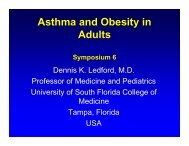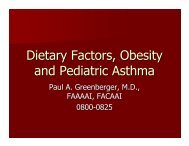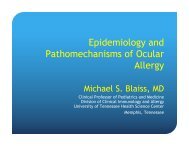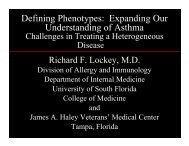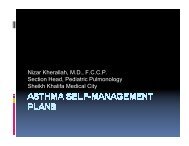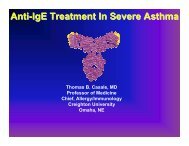Dubai Final-v20.indd - World Allergy Organization
Dubai Final-v20.indd - World Allergy Organization
Dubai Final-v20.indd - World Allergy Organization
You also want an ePaper? Increase the reach of your titles
YUMPU automatically turns print PDFs into web optimized ePapers that Google loves.
ABstrACts<br />
ABstrACts<br />
2. rAPiDCUts “a rapid fat burning catalyst”, to take 1 pack BiD, with ingredients in each pack including (i) magnolia bark extract<br />
(known to contain turbocurarine) and (ii) caffeine 298mg (less than 400mg of caffeine per day from all sources, recommended by<br />
Health Canada).<br />
3. CHinA tUng sHUEH Pills “pill for blood thinning”, containing “radix salvine miltiorrhizae [sic]” with potential herb-drug<br />
interaction with warfarin.<br />
4. FU Zi li ZHOng WAn “nausea extract for gastric bloating”, containing prepared aconite root (Aconitum carmichaeli) with potential<br />
adverse cardiac side effect.<br />
Conclusions: there are potential adverse reactions in CAm and Ds purchased in Chinese herbal shops and health food stores in<br />
north America. Physicians should inquire the use of CAm and Ds by patients. there should be higher standard in regulation in CAm<br />
and Ds in north America.<br />
2201<br />
inTErim FinDingS From ESTaBliSHing THE EFFECTiVEnESS, CoST-EFFECTiVEnESS anD SaFETY oF oral anD<br />
SUBlingUal immUnoTHEraPY For FooD allErgY: a SYSTEmaTiC rEViEW<br />
nurmatov, U. 1 , Devereux, g. 2 and sheikh, A. 1<br />
1<strong>Allergy</strong> & respiratory research group, Centre for Population Health sciences, the University of Edinburgh, Edinburgh, United<br />
Kingdom. 2Department of Child Health, royal Aberdeen Children’s Hospital, the University of Aberdeen, Aberdeen, United Kingdom.<br />
Background: the prevalence of food allergy in children has increased in recent decades. Oral and sublingual immunotherapy<br />
aims to desensitise people and induce immunological tolerance, enabling igE-mediated food allergic patients to consume increased<br />
quantities of the food(s) in question. this is a promising new therapeutic approach and a careful critique and synthesis of the<br />
literature will be an important contribution towards establishing the safety, effectiveness and cost-effectiveness of this approach.<br />
objectives: to identify and critically review the published and unpublished evidence for the effectiveness and safety of oral and<br />
sublingual immunotherapy in people with igE-mediated food allergy.<br />
methods: systematic review and meta-analysis of all interventional studies i.e. randomised controlled trials (rCts), quasi-rCts<br />
and controlled clinical trials (CCts) were identified from searching 11 electronic databases. the primary outcomes of interest are<br />
the recovery rate from food allergy as assessed by the ability to consume increased amount of the offending food allergen whilst<br />
on treatment (i.e. desensitisation) and success rates for complete tolerance to the causative food. secondary outcomes of interest<br />
include the frequency and severity of local/systematic adverse events, quality of life, health services use including emergency<br />
department contacts and hospital admissions, and data on cost-effectiveness both from the perspectives of patients/families and<br />
healthcare providers.<br />
interim findings: Our searches identified 721 potentially relevant papers; after de-duplication, 626 potentially eligible papers were<br />
included for screening. 606 studies were excluded for not meeting review criteria and another 20 potentially appropriate abstracts<br />
reviewed, of which 11 satisfied our inclusion criteria. there were seven rCts and four CCts; nine of these trials relate to oral<br />
immunotherapy and the remaining two are concerned with assessing sublingual therapy. Analyses are underway and results will be<br />
presented at the conference.<br />
implications: this work will clarify the evidence base for the use of oral and sublingual immunotherapy in people with igEmediated<br />
food allergy and will inform national and international deliberations on service provision.<br />
2202<br />
CiSPlaTin aDminiSTraTion FolloWing aCUTE HYPErSEnSiTiViTY To oTHEr PlaTinUm ComPoUnDS: a PHaSE ii STUDY<br />
syrigou, E. , makrilia, n. , Politi, K. , Kaklamanos, g. , manolopoulos, l. and syrigos, K. n.<br />
Oncology Unit, 3rd Department of medicine, sotiria general Hospital, Athens school of medicine, greece, Athens, greece.<br />
Platinum compounds are antineoplastic agents widely used in numerous malignancies. A high percentage of patients exhibit<br />
carboplatin-associated hypersensitivity, especially after their seventh course of chemotherapy. the purpose of this study was to<br />
determine how useful skin tests are in ruling out cross-reaction to cisplatin, especially when treating physicians wish to continue<br />
platinum-based chemotherapy in patients responsive to these drugs. Prick tests were performed on three patients with medium<br />
and severe hypersensitivity to carboplatin. these tests were followed by intradermal tests with a series of carboplatin and cisplatin<br />
dilutions. Prick tests were negative for both carboplatin and cisplatin, whereas, in all patients, intradermal tests were positive with<br />
carboplatin and negative with cisplatin. Cisplatin was administered instead of carboplatin and was well tolerated by all patients<br />
without administering premedication. We reach the conclusion that intradermal skin tests can be used to detect cross-reaction<br />
between platinum compounds in order that platinum-based therapy is safely continued with a different platinum agent. this method<br />
requires neither desensitization nor premedication.<br />
www.worldallergy.org 124<br />
FinAl PrOgrAm





